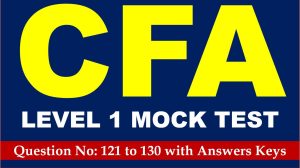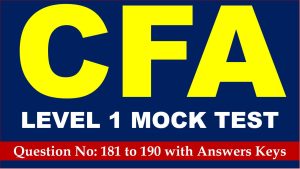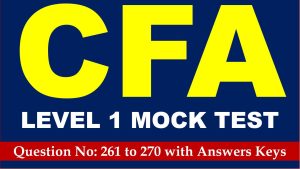Hi CFA Aspirants, welcome to AKVTutorials. Are you preparing for CFA Level 1, 2, 3 exams for making a career in CFA (Charted Financial Analyst). According to CFA Wikipedia, CFA The Chartered Financial Analyst (CFA) program is a postgraduate professional certification offered internationally by the American-based CFA Institute. A candidate who successfully completes the program and meets other professional requirements is awarded the “CFA charter” and becomes a “CFA charter holder”. Therefore, you need CFA Study Notes and Free CFA Level 1 Practice Test 34 Questions Bank Answer Keys AMBIPi.
In this article, you will get Free CFA Level 1 Mock Exam Practice Questions.
Free CFA Level 1 Mock Practice Exam Questions Bank
Free CFA Level 1 Practice Question No: 331:
The mosaic theory holds that an analyst:
Option A: Can use material public information or nonmaterial nonpublic information in the analyst’s analysis.
Option B: Should distinguish between facts and opinions in research reports.
Option C: Should use all available and relevant information in support of an investment recommendation.
Option D: Violates the Code and Standards if the analyst fails to notify her or his employer of the Code and Standards fails to have knowledge of and comply with applicable laws.
Show/Hide Answer
Option A : an use material public information or nonmaterial nonpublic information in the analyst’s analysis.
This question pertains to Standard V (A), Prohibition against Use of Material Nonpublic Information. The mosaic theory states that an analyst may use material public information or nonmaterial nonpublic information in creating a larger picture than shown by any individual piece of information and the conclusions drawn become material only after the pieces are assembled. All the other answers describe violations of the Code and Standards, but are not the mosaic theory.
CFA Level 1 Exam Question No: 332:
Portfolios that include more than one asset class are called ____________ portfolios.
Option A: Quasi-asset.
Option B: multivariate.
Option C: multiple leverage.
Option D: univariate-asset.
Option E: multiple-asset.
Show/Hide Answer
Option E : multiple-asset.
If the firm does not have discretion over the asset mix, the segments of the various asset classes, with their respective cash positions, must be included in composites composed of like assets.
Free CFA Level 1 Mock Exam Question No: 333:
The Standards state that when presenting material to others, members shall not “copy or use, in substantially the same form as the original, material prepared by another without acknowledging and identifying the name of the author, publisher, or source of such material.” The analyst may use information from other sources without acknowledgment, however, if the information:
Option A: is factual information published in recognized financial and statistical reporting services.
Option B: does not include a buy or sell recommendation.
Option C: was originally communicated verbally.
Option D: is being reported only to the member’s employer or associates.
Show/Hide Answer
Option A : is factual information published in recognized financial and statistical reporting services.
This question relates to Standard II (C), Prohibition against Plagiarism, which states that members may use factual information published in recognized financial and statistical reporting services without attribution. Even if the information is communicated verbally, members must use proper attribution of the material. Whether or not the plagiarized material is combined with a buy/sell recommendation or reported only to the member’s employer or associates does not change the fact that the member is copying material without acknowledgment.
CFA Level 1 Free Practice Question No: 334:
Smithers is a financial analyst with XYZ Brokerage Company. She is preparing a purchase recommendation on JNI Corporation. Which of the following situations would represent a conflict of interest for Smithers and, therefore, would have to be disclosed?
I. Smithers is on a retainer as a consultant to JNI.
II. XYZ holds for its own account a substantial common stock position in JNI.
III.Smithers has material beneficial owners of JNI through a family trust.
IV. Smithers’ brother-in-law is a supplier to JNI.
Option A: II and III only.
Option B: I, II and III only.
Option C: II only.
Option D: I and IV only.
Option E: III only.
Option F: IV only.
Option G: I only.
Option H: I. II and IV only.
Show/Hide Answer
Option B : I, II and III only.
This question pertains to Standard IV (B.7), Disclosure of Conflicts to Clients and Standard III (C), Disclosure of Conflicts to Employer. Statements I, Il and III describe conflicts of interest for Smithers or for her firm that would have to be disclosed. Statement I describes an employment relationship between the analyst and the company subject to recommendation. Statement I describes the beneficial interest of the analyst’s employer in the company’s stock. Statement Ill describes the analyst’s own beneficial interest in the company stock. In Statement IV, the relationship between the analyst and the company through a relative is so tangential that it does not create a conflict of interest necessitating disclosure.
Free CFA Practice Question No: 335:
When a trustee for private investment funds has responsibility toward current beneficiaries who are income oriented and future beneficiaries (“remaindermen”) who are capital growth oriented, she has primary fiduciary duty toward:
Option A: both have to be treated on the same footing.
Option B: the income beneficiaries.
Option C: the remaindermen.
Option D: insufficient information.
Show/Hide Answer
Option A : both have to be treated on the same footing.
Personal trust account trustees are subject to the “Prudent Man Rule” in their investment behavior and are required to follow the guidelines of the trust. In particular, when there are conflicting interests involved, the trustee is required to maintain an equitable balance between the interests of different groups. Standard IV (B.1) – Fiduciary Duties – and the Topical Study, “Fiduciary Duty.“
CFA Level 1 Sample Question No: 336:
Level II verifiers must obtain and review proper recording of cash flows ________ to ensure proper recording of cash flows.
Option A: end of period returns.
Option B: accounting methods.
Option C: bank reconciliation.
Option D: cash flow statements.
Show/Hide Answer
Option C : bank reconciliation.
This procedure must be carried out to determine whether capital contributions and withdrawals that are used in the performance calculations are recorded in the proper accounts, at the right amounts and on a timely basis.
Free CFA Level 1 Quiz Question NO: 337:
Standard IV (B) is known as _________.
Option A: Preservation of Confidentiality.
Option B: Duty to Employer.
Option C: Professional Misconduct.
Option D: Prohibition against Use of Material Nonpublic Information.
Option E: Interactions with Clients and Prospects.
Option F: Investment Process.
Option G: Fair Dealing.
Option H: None of these answers.
Show/Hide Answer
Option E : Interactions with Clients and Prospects.
Standard IV (A) deals with the Investment Process. Standard III (B) deals with Duty to Employer. Standard IV (B.3 deals with Fair Dealing. Standard IV (B) deals with Interactions with Clients and Prospects. Standard V (A) deals with Prohibition against Use of Material Nonpublic Information. Standard IV (B.5) deals with Preservation of Confidentiality. Standard II (B) deals with Professional Misconduct.
Free CFA Level 1 Quiz Question NO: 338:
The ERISA fiduciary needs to be as prudent as
Option A: the average investment advisor.
Option B: the average person.
Option C: the average expert.
Option D: none of these answers.
Show/Hide Answer
Option A : the average investment advisor.
Under ERISA, the fiduciary is held to a higher standard than the Prudent Man Rule. The ERISA fiduciary needs to be as prudent as the average expert, not simply as prudent as the average person. Like all fiduciaries, however, the ERISA fiduciary must act solely in the best interest of the plan participants and beneficiaries and use all available care, skill, prudence and diligence.
Free CFA Practice Question No: 339:
Ward is scheduled to visit the corporate headquarters of Evans Industries. Ward expects to use the information obtained to complete his research report on Evans stock. Ward learns that Evans plans to pay all of Ward’s expenses for the trip, including the cost of meals, hotel room and air transportation.
Which of the following actions would be the best course for Ward to take under the Code and Standards?
Option A: Accept the expense-paid trip and write an objective report.
Option B: Write the report without taking the trip.
Option C: Pay for all travel expenses, including costs of meals and incidental items.
Option D: Accept the expense paid trip but disclose the value of the services accepted in the report.
Show/Hide Answer
Option C : Pay for all travel expenses, including costs of meals and incidental items.
The best course of action, under Standard IV (A.3), Independence and Objectivity, is to avoid a conflict of interest whenever possible. Therefore, paying for all expenses is the correct answer. Merely disclosing the conflict is not as appropriate as avoiding the conflict of interest altogether. Writing an objective report would not remove the appearance of a conflict of interest. Not taking the trip is incorrect, because Ward would not be taking advantage of close inspection of the company and his report would not be using all the information available.
CFA Mock Exam Free Question No: 340:
When creating composites, asset-plus-cash returns _________ returns must be not be mixed with asset-plus-cash-return.
Option A: model.
Option B: portfolio.
Option C: asset-only.
Option D: cash.
Option D: performance.
Show/Hide Answer
Option C : asset-only.
To be in compliance with the PS, a firm creating a composite must meet this requirement.



